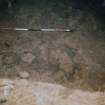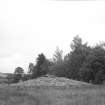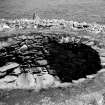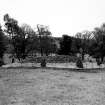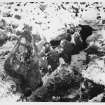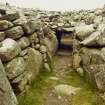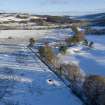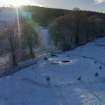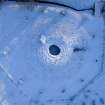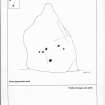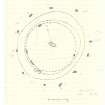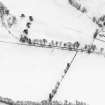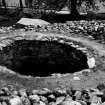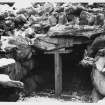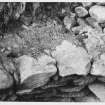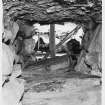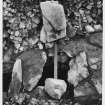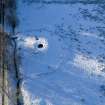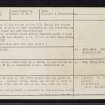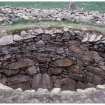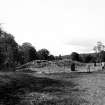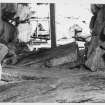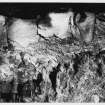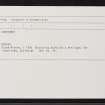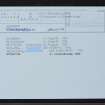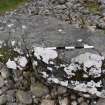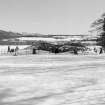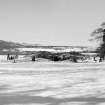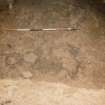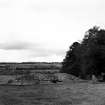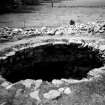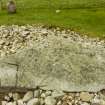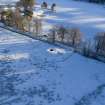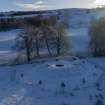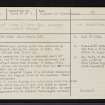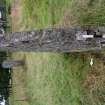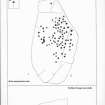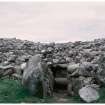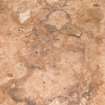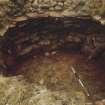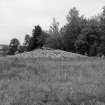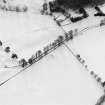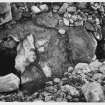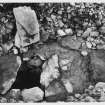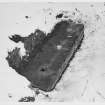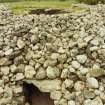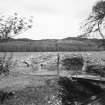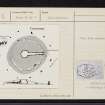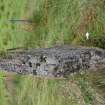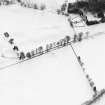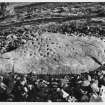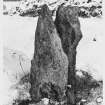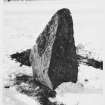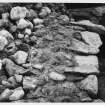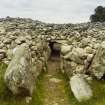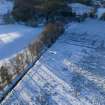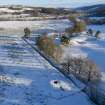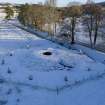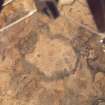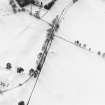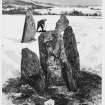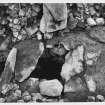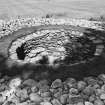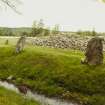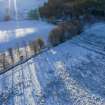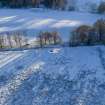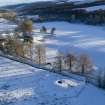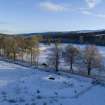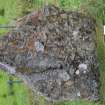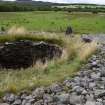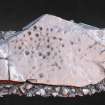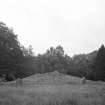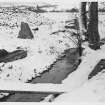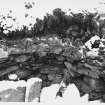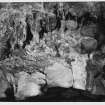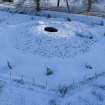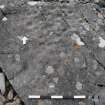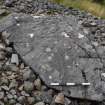Corrimony
Chambered Cairn (Neolithic), Cup Marked Stone(S) (Neolithic) - (Bronze Age), Stone Circle (Neolithic) - (Bronze Age)
Site Name Corrimony
Classification Chambered Cairn (Neolithic), Cup Marked Stone(S) (Neolithic) - (Bronze Age), Stone Circle (Neolithic) - (Bronze Age)
Alternative Name(s) Corrimony 1; Corrimony 2
Canmore ID 12256
Site Number NH33SE 6
NGR NH 3830 3030
Datum OSGB36 - NGR
Permalink http://canmore.org.uk/site/12256
First 100 images shown. See the Collections panel (below) for a link to all digital images.
- Council Highland
- Parish Urquhart And Glenmoriston
- Former Region Highland
- Former District Inverness
- Former County Inverness-shire
NH33SE 6 3830 3030.
(NH 3830 3030) Stone Circle {NR}
OS 6"map, Inverness-shire, 2nd ed., (1904)
This Clava-type passage grave was excavated by Professor Piggot, during the summer of 1952. His excavation has now been filled in.
Before excavation the cairn measured about 60' in diameter, and 8' in height, and was composed, for the most part, of water-worn stones. A large, flat, cup-marked stone, now thought to have been the cap-stone of the chamber lay on top.
Excavation revealed traces of a crouched inhumation burial beneath the flagged floor of the chamber. There were no grave-goods.
Of the 11 stones forming the outer ring round the cairn 4 are modern additions and 2 have been reset in recent times. The stones range from 5' - 9' in height. An area of cobbling, apparently an original feature, was revealed between two of the stones on the NW. One of the stones on the NW is said to bear cup-marks on its outer-facing side, but these are now unconvincing.
The only artifact found during excavation, was a bone pin, calcined and eroded, which is now in the National Museum of Antiquities of Scotland (NMAS, EO 956).
S Piggott 1956; A S Henshall 1963
A stone on the NW side of the outer circle has cup marks on the outer face. Another stone, which lay on the W side of the cairn until 1830, and is now on the top, also has cup marks.
A Mitchell 1875
This cairn, surrounded by a fence, is maintained by the MOW. It is as described above.
Resurveyed at 1/2500.
Visited by OS (N K B) 4 December 1964
Field Visit (15 September 1943)
Chambered cairn, Corrimony.
What the OS map describes as a stone circle stands on a dead-level, rather marshy meadow close to the road from Glen Urquhart to Corrimony about ½ mile due E of the old house. It is actually an intact cairn 8ft to 10ft [2.4m to 3m] high surrounded by a circle of 11 orthostats. The cairn consists almost entirely of rounded water-worn boulders covered in grass on its flanks but naked after the first couple of feet. Though the surface of the stony slope the top edges of five very large upright boulders just project on the SW and N while a sixth on the SW has been fully exposed by digging into the cairn and has fallen outwards as a result. These stones stand on the periphery of a circle of about 51ft [15.5m] diameter and presumably represent the peristalith of the cairn as they resemble the blocks in the peristalith on Clava and cairns of that group. The largest block visible on WSW is 5ft 6in [1.7m] long tangentially.
Cairn material certainly now extends well beyond this peristalith that does not interrupt the smooth slope from the cairns summit. The actual limits of the spread are naturally ill-defined; bare stones form an oval about 58ft [17.7m] E to W by 55ft [16.8m] N to S while under the turf the stones extent 74ft [22.6m] by 65ft [19.8m] reaching to the base of the orthostates on the W.
The 11 orthostats form a very irregular circle about 82ft [25m] N to S by 76ft [23.2m] E to W. The stones are set at intervals of from 15ft to 25ft [7.6m] save on the E where there is a gap if 35ft [10.7m]. A stone may have been removed from this point. A large slab that now lies prostrate on the summit of the cairn may once have stood here;* it measures 7ft 3in [2.2m] by 3ft 6in [1.1m] by 1ft 9in [0.5m] and bears on the exposed surface at least 44 cup-marks. The orthostat No. 10 on the WNW also bears five cup-marks on the face away from the cairn. [dimensions of orthostats given]
Though no chamber is exposed, the free-standing circle, the peristalith slabs and the cupmarks justify the inference that this in an intact cairn of the sort so familiar along the Nairn and Spey and on both sides of the Beauly Firth. As such the monument is certainly worthy of preservation though it does not seem to be in any danger.
Visited by RCAHMS (VG Childe), 15 September 1943
*For a suggestion that it may have been placed in its present position in 1830, cf PSAS, x, p.643
Publication Account (1995)
This cairn is a well-preserved passage grave of Clava type. As usual, the cairn is retained by a ring of large boulders. A long passage leads through the cairn material into the small central chamber, and part of this passage is still roofed with the original stone slabs, whereas at Clava these are missing. The passage is only about one metre hi gh, and so can only be entered crouched or crawling. The walls of the chamber have a basal ring of boulders, above which is drystone walling that oversails in its higher courses but is now open in the centre. The roof was originally corbelled inwards until the rop could be closed with one large slab, and then covered with the stones of the cairn. The massive cup-marked slab now lying on top of the cairn was probably the capstone. The passage and chamber had a cobbled floor. In the 19th century the chamber had been dug out down to this floor and refilled. New excavations in 1953 discovered the stain of a single crouched body buried below the cobbled floor.
A ring of eleven standing stones surrounds the cairn, and though there seems to be space for a twelfth it may never have been erected. The four circle stones closest to the passage entrance have been re-erected at some time, and the two west of the entrance are not original, but made out of two lintels from the passage roof.
Information from ‘Exploring Scotland’s Heritage: The Highlands’, (1995).
Aerial Photography (14 December 2012)
HES undertook UAV aerial photography at Corrimony and upper Glen Urquhart on 14 December 2022.
The survey consisted of the capture of 48 oblique aerial photographs of two hut circles, two farmsteads and the well-known chambered cairn. The imagery was captured using a DJI Inspire 2 UAV (X7/FC6540 camera and 24mm equivalent lens). The oblique images were edited in Adobe Photoshop CC and archived as both raw (DNG) and tiff formats.
Visited by HES Archaeological Survey (GF Geddes and D M Bratt), 15 December 2022.
Note
Date fieldwork started: 04/08/2020
Compiled by: NOSAS
Corrimony 1
Scotland's Rock Art Project ID: 3487
Location notes: The panel lies on top of the Corrimony, a Clava type cairn. The cairn is a 'Property in Care' and monitored by Historic Environment Scotland and regularly visited by the public. The cairn is situated immediately to the NNW of the minor road to Corrimony, on the flat ground about 220m S of the River Enrick. The cairn and associated standing stones are enclosed by a metal fence and approached across a footbridge over the ditch between the road and cairn. Another cupmarked stone, Corrimony 2, is on one of the standing stones to the N of the cairn.
Panel notes: The panel is a roughly triangular gneiss slab 2.40 x 1.30m and 0.40m thick. It now lies on top of the cairn stones on the E side of the cairn. It is thought to be the capstone of the cairn and was removed about 1830 when the cairn was first excavated. It may have been placed in its present position on the top of the cairn stones during later excavations and some rebuilding of the cairn. The slab has many cupmarks, with approximate 72 cups, 1 dumbbell and 1 set of 3 cups joined with grooves. The stone has a number of fissures across the top but generally has a smooth surface.
Note
Date fieldwork started: 04/08/2020
Compiled by: NOSAS
ScRAP ID: 3534
Corrimony 2
Location notes: This is a standing stone located to the NNW of the Corrimony, a Clava type cairn. The cairn is a 'Property in Care' and monitored by Historic Environment Scotland and regularly visited by the public. The standing stone is situated immediately to the NNW of the minor road to Corrimony on the flat ground about 220m S of the River Enrick. The cairn and associated standing stones are enclosed by a metal fence and approached across a footbridge over the ditch between the road and cairn. Another cupmarked stone, Corrimony 1, forms the capstone of the cairn and lies on the cairn structure.
Panel notes: This schist standing stone may be in its original position but the cairn, first excavated in 1830, has been excavated a number of times since and some of the standing stones have been re-erected. At present the cup marked side of the standing stone faces roughly NW. The stone is 1.50m high, 1m wide and 0.17m thick and may have been reshaped when it was first used as a standing stone as the top is triangular. There are a few shallow fissures and the stone is covered with lichen. There are 6 circular depressions, at least 4 of which are cupmarks, scattered across the lower half of the standing stone.










































































































